 SOFIA with the telescope door open in flight. | |||
 | |||
| Alternative names | SOFIA | ||
|---|---|---|---|
| Organization | NASA / DLR / USRA / DSI | ||
| Location | Palmdale Airport (most of the year); Christchurch International Airport (for about 2 months around June/July) | ||
| Coordinates | 43°29′22″S 172°31′56″E / 43.48944°S 172.53222°E | ||
| Altitude | ground: 702 m (2,303 ft); airborne: 13.7 km (45,000 ft) | ||
| Established | 2010 | ||
| Closed | September 29, 2022 | ||
| Website | |||
| Telescopes | |||
| |||
| | |||
The Stratospheric Observatory For Infrared Astronomy (SOFIA) was an 80/20 joint project of NASA and the German Aerospace Center (DLR)[1] to construct and maintain an airborne observatory. NASA awarded the contract for the development of the aircraft, operation of the observatory and management of the American part of the project to the Universities Space Research Association (USRA) in 1996. The DSI (German SOFIA Institute; German: Deutsches SOFIA Institut) managed the German parts of the project which were primarily science-and telescope-related. SOFIA's telescope saw first light on May 26, 2010. SOFIA was the successor to the Kuiper Airborne Observatory. During 10-hour, overnight flights, it observed celestial magnetic fields, star-forming regions, comets, nebulae, and the Galactic Center.
Science flights have now concluded, after the landing of the 921st and last flight in the early morning of September 29, 2022. The Boeing 747SP used to carry the telescope has been preserved and put on display at the Pima Air & Space Museum near Tucson, Arizona.
- ^ "SOFIA Science Center". Universities Space Research Association. Retrieved December 25, 2016.
